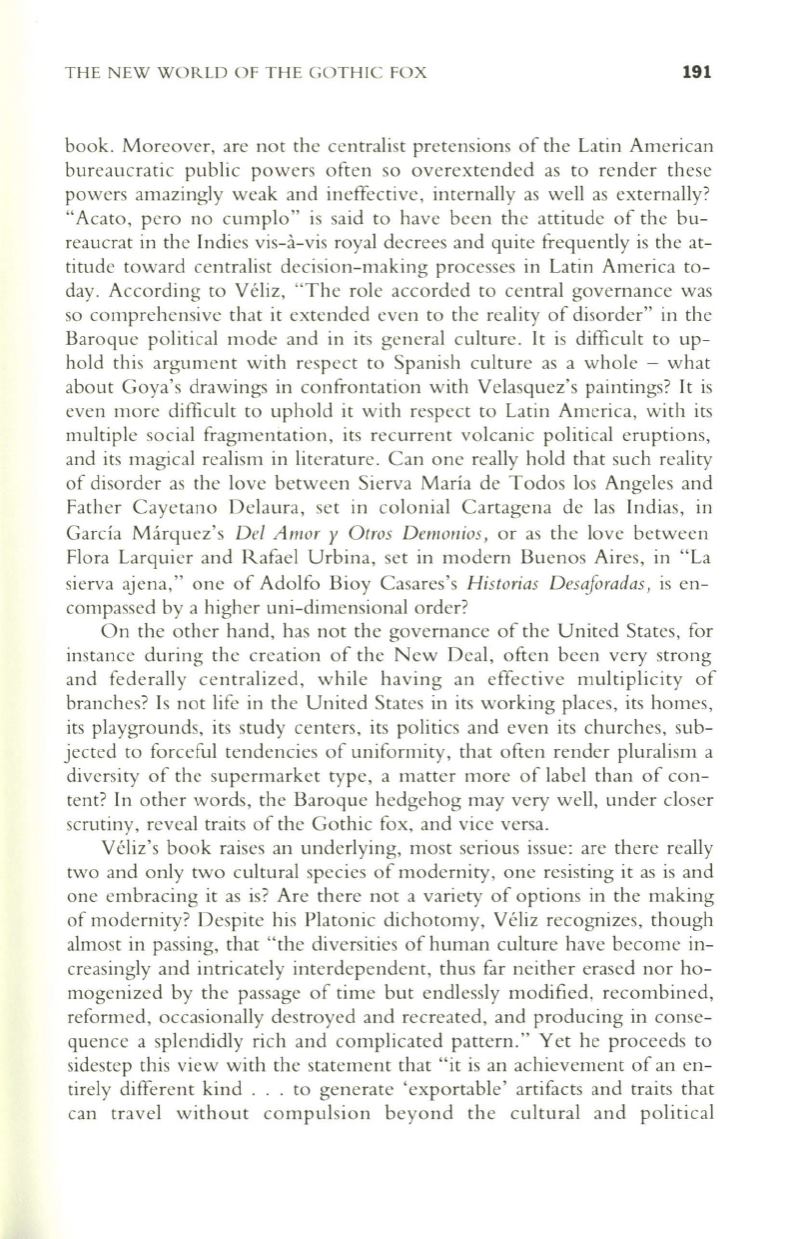
THE NEW WORLD OF THE GOTHIC FOX
191
book . Moreover, arc not the centralist pretensions of the Latin American
bureaucratic public powers often so overextended as to render these
powers amazingly weak and ineffective , internally as well as externally?
"Acato, pero no cumplo" is said to have bccn thc attitudc of the bu–
reaucrat in thc [ndics vis-a-vis royal decrees and quite frequently is the at–
titude toward centralist decision-making processes in Latin America to–
day. Acco rding to V6liz, "The role accorded to central governance was
so comprehensive that it extended evcn to the reality of disorder" in the
Baroque political mode and in its general culture.
[t
is difficult to up–
hold this argumcnt with respcct to Spanish culture as a whole - what
about Goya's drawings in confrontation with Velasquez's paintings?
It
is
even more difficult
to
uphold it with respect to Latin America, with its
multiple social fragmcntation , its recurrent volcanic political eruptions,
and its magical realism in litcraturc. Can onc really hold that such reality
of disorder as the love between Sicrva Maria de Todos los Angeles and
Father Cayetano Delaura, set in colonial Cartagena de las [ndias, in
Garcia Marquez's
Del Amor
y
Otros Demonios ,
or as the love between
Flora Larquier and R.afael Urbina, sct in modern Buenos Aires, in "La
sierva ajena," one of Adolfo Bioy Casares's
Historias Desaforadas,
is cn–
compassed by a higher uni-dimensional order?
On the othcr hand, has not the governance of the United Statcs, for
instancc during the creation of the New Deal, often been very strong
and fcdcrally centralized, while having an effective multiplicity of
branchcs? Is not life in the United States in its working placcs, its homes,
its playgrounds, its study ccnters, its politics and even its churches, sub–
jected to forccful tendencies of uniformity, that often render pluralism a
diversity of the supermarket type, a matter more of label than of con–
tent?
[n
othcr words, the Baroque hedgehog may very well, under closer
scrutiny, reveal traits of the Gothic fox, and vice versa.
Veliz's book raises an underlying, most scrious issue: are there really
two and only two cultural spccies of modernity, one resisting it as is and
one cmbracing it as is? Are there not a variety of options in the making
of modernity? Despite his Platonic dichotomy, Veliz recognizes, though
almost in passing, that "the diversities of human culture have become in–
creasingly and intricately interdependent, thus far ncither erased nor ho–
mogenized by the passage of time but endlessly modified, recombined,
reformed, occasionally destroyed and recreated, and producing in conse–
quence a splendidly rich and complicated pattern." Yet he proceeds to
sidestep this vicw with the statement that "it is an achievemcnt of an en–
tirely different kind ... to generate 'exportable' artifacts and traits that
can travel without compulsion beyond the cultural and political


